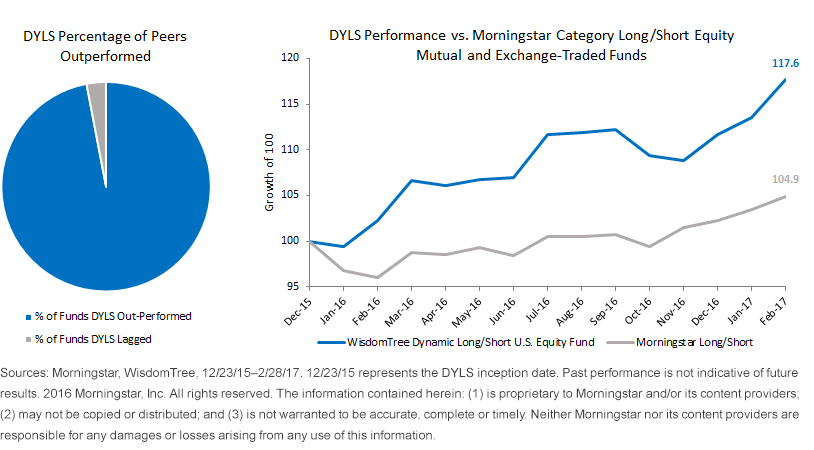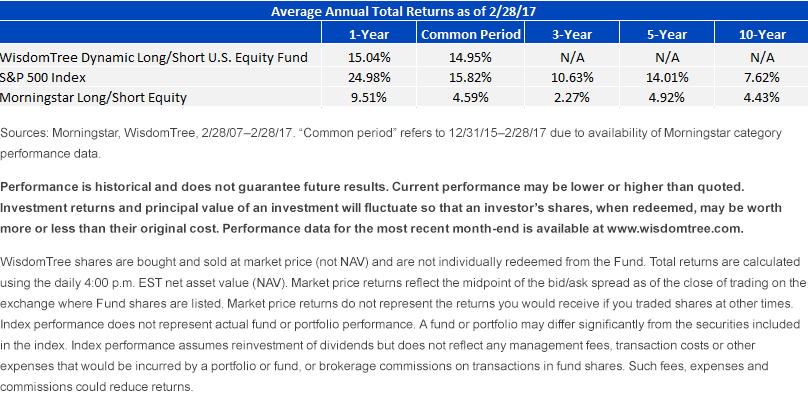How This Long/Short ETF Beat 97% Of Its Peers Since Inception
With U.S. markets near all-time highs, and many investors expressing concerns about market valuations, I thought it would be a good time to review the case for the WisdomTree Dynamic Long/Short U.S. Equity Fund (DYLS), a low-cost1, long/short exchange-traded fund (ETF) we developed that may become increasingly relevant for the current market environment.
DYLS, while having gone live only a little over a year ago, has been performing remarkably well, compared to its peer set of long/short funds. DYLS has a portfolio grounded in the academic factor research that is gaining popularity, and the characteristics of the portfolio today are what many investors would find attractive.
These attributes include:
- Quality Tilts: Having higher profitability figures such as return on equity (ROE) and stronger underlying dividend growth trends
- Value Tilts: Having lower price-to-earnings (P/E) ratios and higher dividend yields
- These tilts being done in a sector-neutral fashion, so the portfolio is not just a value strategy or a quality strategy through sector views.
Starting off, these characteristics help understand the selection process. The strategy looks to find less expensive quality stocks in every sector. But it also looks to dynamically hedge market exposure when fundamentals are deteriorating and valuations are high.
Lower-Fee Alternative Strategy
Our main motivation behind this strategy: many of the funds in this category of long/short investments are quite expensive, and we wanted to be among the low-cost leaders in this category. With DYLS among the top five lowest expense ratios, we believe we have achieved this motive.
In a category where funds may charge performance fees and average net expense ratios that are more than three times our expense ratio, that gives us a great head start.
(Click on image to enlarge)
Beating 97% of Peers
DYLS launched in December of 2015, right ahead of a drop in the market in early 2016. Interestingly, our signals on DYLS started off from a hedged standpoint and the Fund launched fully market neutral. Our hedge ratio is adaptive and can range from being fully invested to fully market neutral, and the hedge ratio came off in March. This strong start in the first three months has led the Fund to be ranked #11 of 299 different Morningstar long/short funds based on risk adjusted returns since its inception—and beating 97% of its competition.
(Click on image to enlarge)
(Click on image to enlarge)
Conclusion
DYLS is pretty unique in the ETF structure. Many firms have long/short strategies in hedge fund or mutual fund structures, where they typically charge much higher fees. I believe one of the growth areas for ETFs will be more systematic factor strategies that also look to add short positions in the market to hedge risk. If one can add value both on the long side of the portfolio and then reduce risk on the hedges—which DYLS has done in real time—one has the potential to create one of the best low-cost long/short strategies around. We believe DYLS could interest those looking at lower-volatility alternatives to U.S. market exposure.
1Ordinary brokerage commissions apply.
Disclosure: None.
Disclaimer: There are risks associated with investing, including possible loss of principal. Foreign investing involves special risks, such as risk of loss from ...
more





